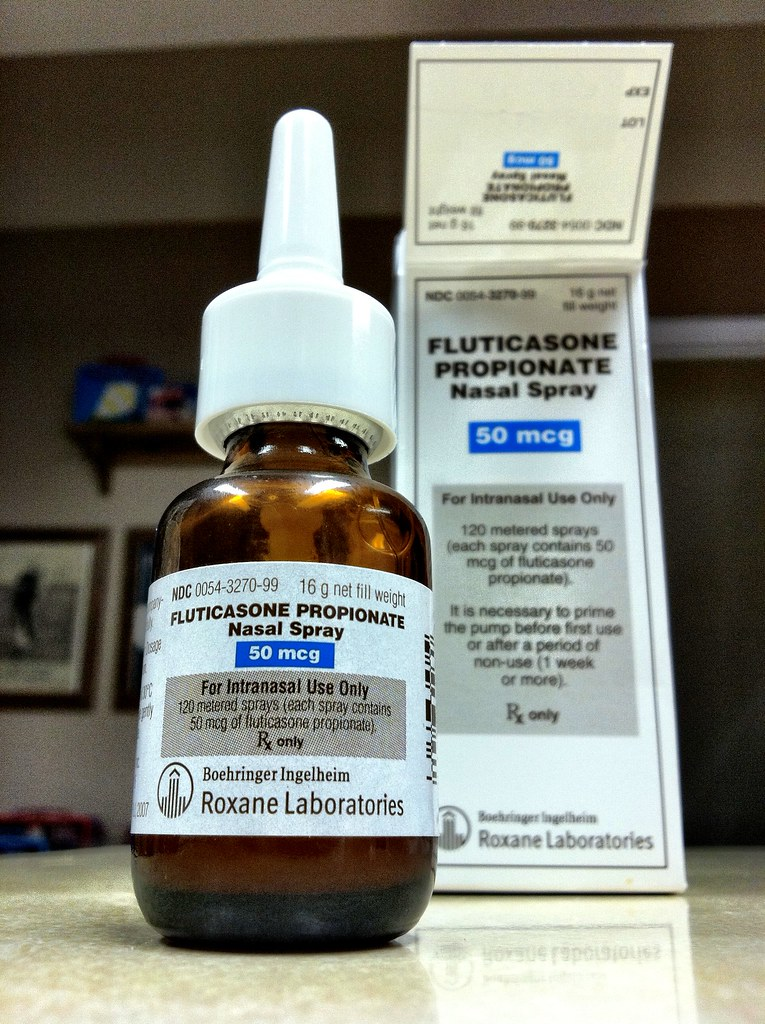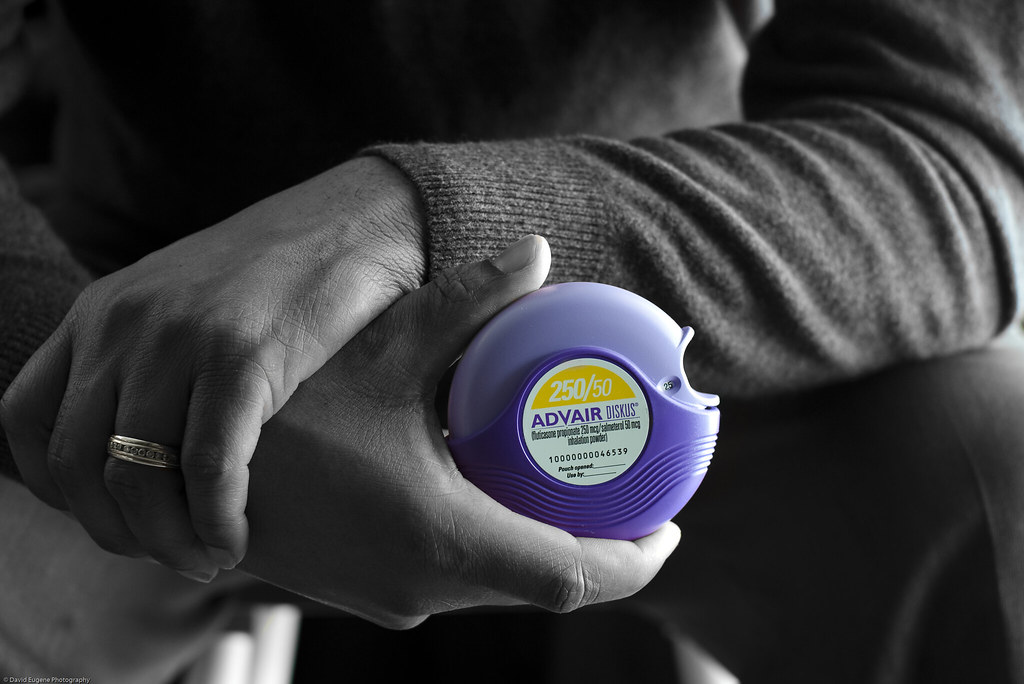5.12 Corticosteriods
Open Resources for Nursing (Open RN)
Corticosteroids can be prescribed in a variety of routes. Fluticasone is an example of a commonly used inhaled corticosteroid; prednisone is an example of a commonly used oral corticosteroid; and methylprednisolone is a commonly used IV corticosteroid. Additional information about corticosteroids and potential adrenal effects is located in the “Endocrine” chapter.
Mechanism of Action
Fluticasone is a locally acting anti-inflammatory and immune modifier. The nasal spray is used for allergies, and the oral inhaler is used for long-term control of asthma. Fluticasone is also used in a combination product with salmeterol. It decreases the frequency and severity of asthma attacks and improves overall asthma symptoms. See Figures 5.14-16[1],[2],[3] for images of different formulations of fluticasone.
Oral prednisone prevents the release of substances in the body that cause inflammation. It also suppresses the immune system.
Methylprednisolone IV prevents the release of substances in the body that cause inflammation. It also suppresses the immune system. Methylprednisolone requires reconstitution before administration. See Figure 5.17[4] for an image of methylprednisolone.
Indications for Use
Fluticasone inhalers are used to prevent asthma attacks. In respiratory conditions, oral prednisone is used to control severe or incapacitating allergic conditions that are unresponsive to adequate trials of conventional treatment for seasonal or perennial allergic rhinitis, bronchial asthma, contact dermatitis, atopic dermatitis, serum sickness, and drug hypersensitivity reactions. Methylprednisolone IV is used to rapidly control these same conditions.
Nursing Considerations Across the Lifespan
Fluticasone is safe for 4 years and older. Prednisone and methylprednisolone are safe for all ages.
Adverse/Side Effects
Fluticasone can cause hoarseness, dry mouth, cough, sore throat, and oropharyngeal candidiasis. Patients should rinse their mouths after use to prevent candidiasis (thrush).
Prednisone and methylprednisolone: See more information about adverse effects of corticosteroids in the “Endocrine” chapter. Cardiovascular symptoms can include fluid retention, edema, and hypertension. Imbalances such as hypernatremia (↑Na), hypokalemia (↓ K+), and increased blood glucose with associated weight gain can occur. CNS symptoms include mood swings and euphoria. GI symptoms can include nausea, vomiting, and GI bleed. In long- term therapy, bone resorption occurs, which increases the risk for fractures; the skin may bruise easily and become paper thin; wound healing is delayed; infections can be masked; and the risk for infection increases. Long-term corticosteroid therapy should never be stopped abruptly because adrenal insufficiency may occur.[5]




Patient Teaching & Education
Patients should be advised that corticosteroids are not used to treat an acute asthma attack. They can cause immunosuppression and suppress signs of infection. Corticosteroids can also cause an increase in blood glucose levels. Patients may experience weight gain, swelling, increased fatigue, bruising, and behavioral changes. These occurrences should be reported to one’s healthcare provider.[6]
Now let’s take a closer look at the medication grid for fluticasone, prednisone, and methylprednisolone in Table 5.12.[7],[8],[9]
Table 5.12 Fluticasone, Prednisone, and Methylprednisolone Medication Grid
Class/Subclass |
Prototype/Generic |
Administration Considerations |
Therapeutic Effects |
Adverse/Side Effects |
|---|---|---|---|---|
| Corticosteroids | fluticasone | Rinse mouth after use
Do not use as a “rescue” medication |
Nasal spray: Used for management of the nasal symptoms of perennial nonallergic rhinitis
Inhaler: Used to improve the control of asthma by reducing inflammation in the airways |
Hoarseness, dry mouth, cough, sore throat, and oropharyngeal candidiasis |
| Corticosteroids | prednisone | Do not use if signs of a systemic infection
When using more than 10 days, the dose must be slowly tapered May increase blood glucose levels |
Used to control severe or incapacitating allergic or respiratory conditions | CV: fluid retention, edema, and hypertension
Electrolytes: ↑Na, ↓K+, ↑Ca, ↑BG CNS: mood swings and euphoria in high doses GI: Nausea/Vomiting, GI bleed MS: bone resorption Skin: acne, paper thin, bruises, infections, and delayed healing Weight gain Adrenal suppression Increased risk for infection and infections can be masked Long-term use may result in Cushing’s syndrome |
| Corticosteroids | methylprednisolone | May increase blood glucose levels | Used to rapidly control severe or incapacitating allergic or respiratory conditions, in sepsis to reduce systemic inflammation, and to treat adrenal insufficiency | Same as prednisone |
- "Fluticasone Propionate Nasal Spray" by _BuBBy_ is licensed under CC BY 2.0 ↵
- "Fluticasone.JPG" by James Heilman, MD is licensed under CC BY-SA 4.0 ↵
- "Asthmatic Control" by David Camerer is licensed under CC BY-NC-ND 2.0 ↵
- "Methylprednisolone vial.jpg" by Intropin is licenced under CC BY 3.0 ↵
- Frandsen, G. & Pennington, S. (2018). Abrams’ clinical drug: Rationales for nursing practice (11th ed.). Wolters Kluwer. ↵
- uCentral from Unbound Medicine. https://www.unboundmedicine.com/ucentral ↵
- This work is a derivative of Pharmacology Notes: Nursing Implications for Clinical Practice by Gloria Velarde licensed under CC BY-NC-SA 4.0. ↵
- Frandsen, G. & Pennington, S. (2018). Abrams’ clinical drug: Rationales for nursing practice (11th ed.). Wolters Kluwer. ↵
- This work is a derivative of Daily Med by U.S. National Library of Medicine in the public domain. ↵

